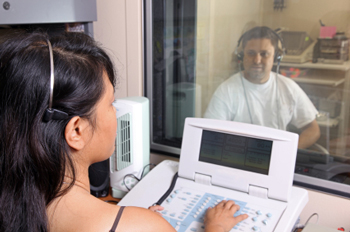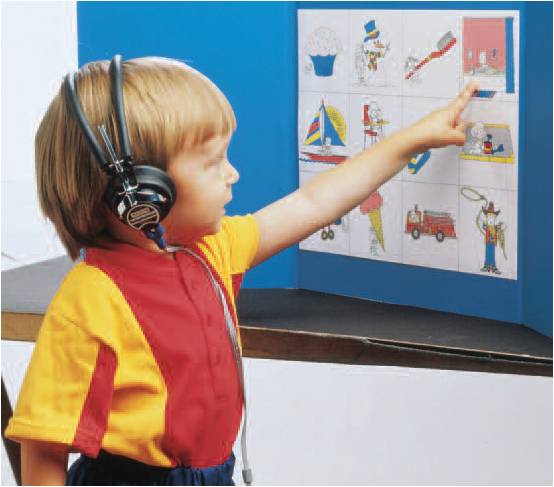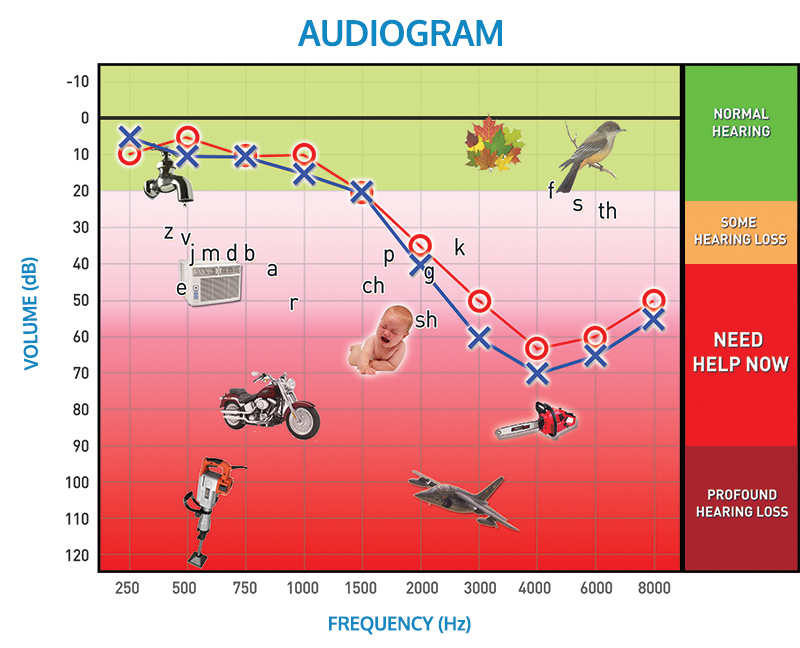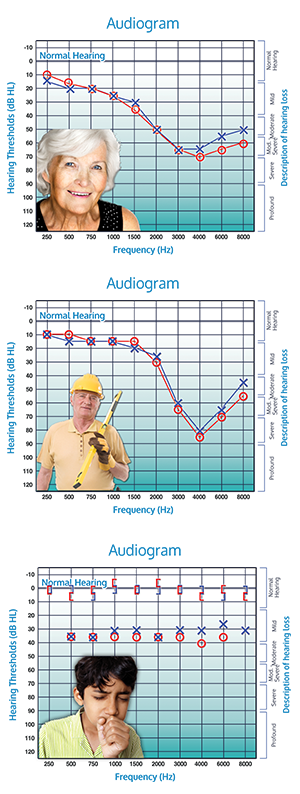When you come in for an initial hearing test consultation at Hearclear Hearing Solutions, we could use a variety of hearing test procedures, which will vary based on reasons for your hearing assessment. Common types of hearing assessments include:
- Hearing Checks or Screening
- Full clinical hearing test (1 hour+)
- Hearing assessments for children and infants
Regardless of what form you hearing test takes, hearing assessments are never painful or invasive procedures – so you have nothing to worry about.
Furthermore, you do not require a GP referral to arrange a hearing test. Just contact us directly at 0499797949 or make an appointment here.
Extra tools and resources
- Unsure of whether you are showing sign of hearing loss? Take our quick online hearing test.

Types of tests
We recommend a full clinical hearing test and consultation at our clinic when screening results or symptoms suggest hearing issues. Additionally, clients referred by a GP or Ear, Nose & Throat Specialists, Workers Compensation, and Office of Hearing Services clients are also provided a full assessment.
Otoscopic inspection
This simply involves looking into the ear canal to check the condition of the ear canal and eardrum.
This inspection can provide a lot of information about what’s happening within the middle ear. It also identifies if there are any visible problems that may influence the results of hearing tests, such as a perforation in the tympanic membrane or compacted build up of cerumen (ear wax).

Pure tone audiometry
Air conduction tests
The simplest way to test hearing is called pure tone audiometry. This involves sitting in a soundproof booth (see photo) and being played a series of beeps and whistles, called pure tones, through headphones or earphones and indicating when you can hear them, generally by pressing a button.
When hearing is measured with pure tones presented through headphones, this measurement is called air conduction. The sounds go via the air, down the ear canal, through the middle ear, and to the very delicate organ of hearing in the inner ear, the cochlea.
The loudness of each tone is reduced until you can just hear the tone. The softest sounds you can hear are known as your hearing thresholds, and these are marked on a graph called an audiogram (to learn how to interpret an audiogram, click here ).
The purpose of the test will find the quietest sounds that you can hear at the full range of frequencies common to human speech, usually 250 Hz to 8000 Hz.
The quietest sounds you can hear, known as hearing thresholds, will be marked on a graph called an audiogram.
This information will determine the degree and type of hearing loss you may have. Hearing loss is measured in decibels (dB), which measure intensity, and pitch in hertz (Hz), which measures frequency. Hearing loss is usually described as normal hearing, mild hearing loss, moderate hearing loss, moderately-severe hearing loss, severe hearing loss, or profound hearing loss.
Bone conduction tests
The sensitivity of the cochlea can also be tested by placing a small vibrator on the mastoid bone behind the ear and, once again, measuring the softest sounds that can be heard. Sounds presented this way travel through the bones of the skull to the cochlea and hearing nerves, bypassing the middle ear.
This type of testing is called bone conduction. The air conduction and bone conduction hearing levels on the audiogram can tell us a lot about where the hearing problem is being caused.
For example, if bone conduction tests indicate less hearing loss than a test through headphones, results would indicate that at least part of the hearing loss could be attributed to conductive hearing loss. Reasons could include fluid in the middle ear, excessive wax, a perforated tympanic membrane or that the bones of the middle ear are not functioning normally.

Speech Tests
The ability to hear speech is a function of the ability to detect and understand the sounds of speech. The range of audible sounds, not just the degree of hearing loss, varies considerably from person to person. Unfortunately, when hearing is damaged it is usually not just the volume of sound heard that is lost, often the quality of the sound is also distorted.
Speech tests are used to determine how clearly someone can understand speech, when visible cues such as lip-reading are removed. They usually involve using common lists of words played (or spoken) at a constant volume that are appropriate to the client’s hearing loss.
The client responds by guessing the word that was spoken and correct and incorrect answers are tallied.
Speech-in-Noise Tests
Given that people with hearing loss commonly have the greatest difficulty understanding speech in the presence of background noise; it makes sense that speech discrimination tests are also performed with the addition of a “noise” stimulus. This is often a ‘speech babble’ played at different volumes relative the speech volume (words or phrases). The client responds by guessing the word or phrase that was spoken in the presence of background noise, and results are tallied.
Aided Vs Unaided Tests
Following the fitting of a hearing device, an Audiologist will run the tests again to compare how their client is able to perform in the speech discrimination tests with the benefit of a hearing aid compared to when they are not wearing a hearing aid.
Tympanograms and Reflex Tests
Tympanograms measure the movement and flexibility of the tympanic membrane to identify whether it is moving normally.
Results may indicate a problem in the middle ear that can cause a conductive hearing loss. When a child has a normal tympanogram, it may also be possible to test for the presence of a muscle reflex – acoustic reflex – in the middle ear. The absence of this reflex to different sounds gives information about the functioning of the auditory system.
What will happen if you come to an appointment?
Full Clinical Assessment
If you require a full clinical assessment (1-hour), you will experience a range of different testing procedures including the types of tests:
- Otoscopy
- Pure Tone Audiometry
- Air conduction
- Bone conduction tests
- Speech Tests
- Speech-in-noise tests
- Tympanogram and Reflex Tests
Contact us today!
If you would like to arrange a hearing test and consultation, call us today on 0499797949 or request an appointment.

Hearing Tests for Children
The ability to test babies and young children has a unique set of problems, related to the child’s age and ability to understand instructions on how to respond. Most children will be assessed using a combination of behavioural and physiological tests.
Play audiometry
This involves testing the child’s hearing when headphones are worn. Play audiometry works the same way as pure tone audiometry (person indicates when they can hear a tone), except when the child hears a tone, they put a marble in a marble race, press a computer key or put a piece in a puzzle.
Electro-physiological tests
Physiological tests help determine which part of the auditory system is involved in the child’s hearing loss. Physiological tests measure a physical response of a specific part of the auditory system and require little or no co-operation from the child.

Distortion Product Otoacoustic Emissions (DPOAEs)
DPOAE’s are used as a diagnostic tool to provide frequency specific information on cochlear outer hair cell function (sensory cells within the inner ear). Using specially designed equipment a plug is positioned in the ear canal and specific sounds are played. In a healthy cochlear these sounds can generate a very soft response (emission) from the cochlear that can then be measured by the plug in the ear canal.
DPOAE testing is a completely objective test and thus does not require any subjective response from the client/patient. It is for this reason that it is used as a newborn hearing screening tool in many countries around the world. DPOAEs are used clinically as a cross check with other audiological tests, including various methods of pure tone audiometry, speech audiometry and immittance audiometry. DPOAEs can also be used as a monitoring tool for individuals being exposed to ototoxic drugs (such as some chemotherapy agents) or dangerous level of noise, as in some cases absent DPOAEs can occur before a hearing loss is showing on the audiogram.
Brainstem evoked response audiometry (BERA)
These look at the electrical activity generated in response to sound along the Cochlea nerve to the brain. It may be carried out while a baby is in natural sleep.
Electro-cochleography (ECOCHG OR ECOG)
This is a medical test performed in hospital, under anaesthetic. It picks up the tiny electrical signals generated in the cochlea in response to sound and provides information about the functioning of the cochlea and cochlea (hearing) nerve.
How to read an audiogram
The Audiogram is the graphical representation of the results of the air conduction and bone conduction hearing tests.
The vertical lines represent the test frequencies, arranged from low pitched on the left to high pitched on the right. The horizontal lines represent loudness, from very soft at the top to very loud at the bottom.
The Audiogram shows the minimum volume at which a person can detect a tone played at a particular frequency. “X” is used for the left ear and “O” represents scores for the right ear. The scores are compared to results obtained from persons with normal hearing (i.e. the line at 0dB).
Sometimes the audiogram will also show bracket symbols “[” and “]”. These represent scores based on bone conduction tests, which as discussed earlier, bypass the outer ear and middle ear.

Interpreting the Audiogram
The Audiologist will use the following characteristics of the audiogram to explaining the results of the audiogram:
Type of hearing loss
- Conductive – Normal hearing for bone conduction scores ([ & ]), and showing a hearing loss for Air Conduction scores (X & O)
- Sensorineural – Hearing loss (equally) for both air and bone conduction
- Mixed – Hearing loss for bone conduction score, and an even greater hearing loss for Air conduction scores
Severity of loss
The lower the scores fall on the Audiogram, the more severe the hearing loss.
Slope of loss
- Flat loss – A hearing loss where hearing is relatively even across all frequencies, which is more common for conductive hearing losses.
- Sloping loss – Increasing degree of hearing loss the higher the frequency. This is the most common hearing loss that will be shown due to the ageing process and noise damage.
- Other – Less common shapes include reverse slopes, cookie bites, corner audiogram
How the ears compare
- Monaural loss: Loss is only in one ear
- Binaural loss: Loss is in both ears
- Symmetrical: Hearing is relatively even in both ears
- Asymmetrical: Hearing loss in one ear is significantly worse than the other ear.
“My hearing is pretty good other than for those high frequencies”
In interpreting an audiogram, it is a common for people to misinterpret the results ~ looking at the good news rather than taking in the whole story.
Low frequencies of sounds found in speech (125 Hz – 1000 Hz) are largely responsible for a person’s interpretation of the volume of speech. High frequencies are responsible for the clarity that someone interprets speech. Some of the high frequency elements of speech include those made by words containing letters such as “f”, “ph”, “th”, “s” and “t”.
Because these sounds are difficult for someone with high frequency loss to hear, they may often mistake what someone has said.
For this reason, many people with greater losses in the higher frequencies commonly feel that: “I can hear ok, it is just that people sound like they’re mumbling”.
Common Audiograms
Here we can see the Audiograms of three people:
- Annie (75 years) – Housewife and grandmother
- Bill (55-years) – Carpenter
- David (12-years) – Passionate cricketer
Presbycusis: Hearing loss caused by ageing process
Annie has a moderate hearing loss that is known as Presbycusis. This results from degeneration of the hair receptors within the cochlear due to the ageing process. Before she was fitted with hearing aids, Annie always found conversations with her younger grandchildren particularly difficult – especially when in a noisy situation. She also found telephone conversations difficult and noisy restaurants were the “bane of her existence”.
Noise induced hearing loss
Bill has been on the tools for 40-years as a carpenter and admits to rarely using ear protection for most of that time. His sharply sloping loss in the higher frequencies can largely be put down to noise induced hearing loss produced by electrical saws and other equipment that he has used in his job.
Conductive hearing loss
David is currently suffering from a conductive hearing loss due to a nasty illness that has led to fluid gathering in his middle ear. He is not hearing very well at the moment and his ears are hurting and “feel tight on the inside”. This infection is causing a problem with the passing of sound through his middle ear, as can be seen by the Normal hearing scores he has from his Bone conduction tests, represented by the “[” and “]”, but impaired Air Conduction results.


